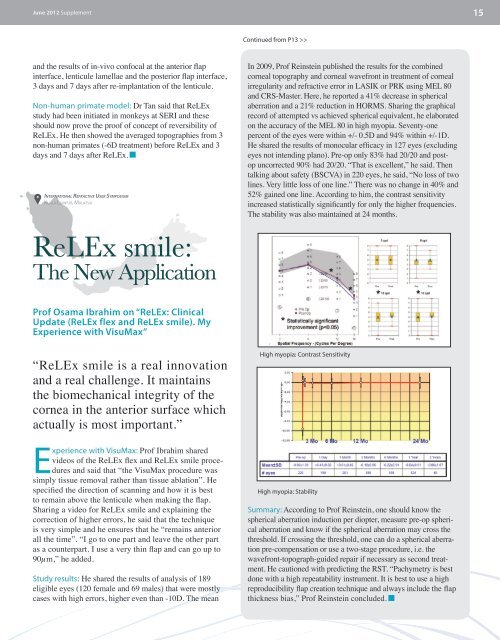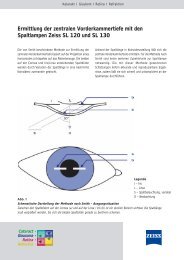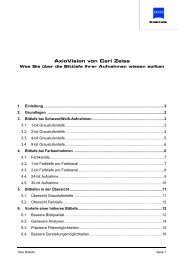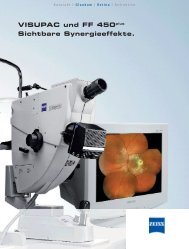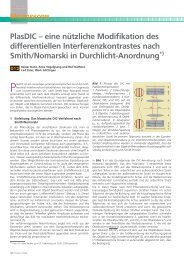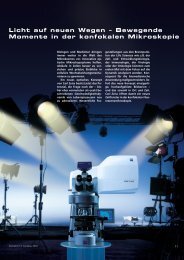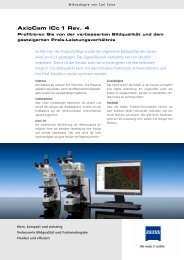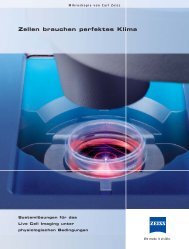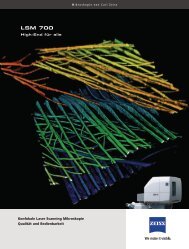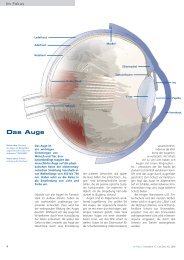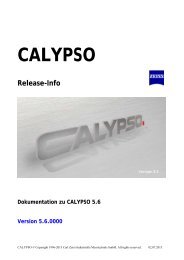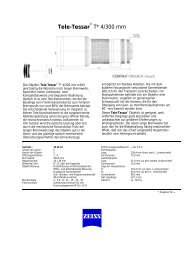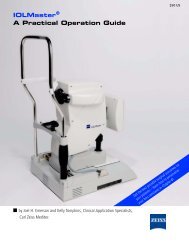FEMTO-LASIK and BEYOND - Carl Zeiss, Inc.
FEMTO-LASIK and BEYOND - Carl Zeiss, Inc.
FEMTO-LASIK and BEYOND - Carl Zeiss, Inc.
You also want an ePaper? Increase the reach of your titles
YUMPU automatically turns print PDFs into web optimized ePapers that Google loves.
June 2012 Supplement<br />
15<br />
Continued from P13 >><br />
<strong>and</strong> the results of in-vivo confocal at the anterior flap<br />
interface, lenticule lamellae <strong>and</strong> the posterior flap interface,<br />
3 days <strong>and</strong> 7 days after re-implantation of the lenticule.<br />
Non-human primate model: Dr Tan said that ReLEx<br />
study had been initiated in monkeys at SERI <strong>and</strong> these<br />
should now prove the proof of concept of reversibility of<br />
ReLEx. He then showed the averaged topographies from 3<br />
non-human primates (-6D treatment) before ReLEx <strong>and</strong> 3<br />
days <strong>and</strong> 7 days after ReLEx. <br />
International Refractive User Symposium<br />
Kuala Lumpur, Malaysia<br />
In 2009, Prof Reinstein published the results for the combined<br />
corneal topography <strong>and</strong> corneal wavefront in treatment of corneal<br />
irregularity <strong>and</strong> refractive error in <strong>LASIK</strong> or PRK using MEL 80<br />
<strong>and</strong> CRS-Master. Here, he reported a 41% decrease in spherical<br />
aberration <strong>and</strong> a 21% reduction in HORMS. Sharing the graphical<br />
record of attempted vs achieved spherical equivalent, he elaborated<br />
on the accuracy of the MEL 80 in high myopia. Seventy-one<br />
percent of the eyes were within +/- 0.5D <strong>and</strong> 94% within +/-1D.<br />
He shared the results of monocular efficacy in 127 eyes (excluding<br />
eyes not intending plano). Pre-op only 83% had 20/20 <strong>and</strong> postop<br />
uncorrected 90% had 20/20. “That is excellent,” he said. Then<br />
talking about safety (BSCVA) in 220 eyes, he said, “No loss of two<br />
lines. Very little loss of one line.” There was no change in 40% <strong>and</strong><br />
52% gained one line. According to him, the contrast sensitivity<br />
increased statistically significantly for only the higher frequencies.<br />
The stability was also maintained at 24 months.<br />
ReLEx smile:<br />
The New Application<br />
Prof Osama Ibrahim on “ReLEx: Clinical<br />
Update (ReLEx flex <strong>and</strong> ReLEx smile). My<br />
Experience with VisuMax”<br />
“ReLEx smile is a real innovation<br />
<strong>and</strong> a real challenge. It maintains<br />
the biomechanical integrity of the<br />
cornea in the anterior surface which<br />
actually is most important.”<br />
High myopia: Contrast Sensitivity<br />
Experience with VisuMax: Prof Ibrahim shared<br />
videos of the ReLEx flex <strong>and</strong> ReLEx smile procedures<br />
<strong>and</strong> said that “the VisuMax procedure was<br />
simply tissue removal rather than tissue ablation”. He<br />
specified the direction of scanning <strong>and</strong> how it is best<br />
to remain above the lenticule when making the flap.<br />
Sharing a video for ReLEx smile <strong>and</strong> explaining the<br />
correction of higher errors, he said that the technique<br />
is very simple <strong>and</strong> he ensures that he “remains anterior<br />
all the time”. “I go to one part <strong>and</strong> leave the other part<br />
as a counterpart. I use a very thin flap <strong>and</strong> can go up to<br />
90µm,” he added.<br />
Study results: He shared the results of analysis of 189<br />
eligible eyes (120 female <strong>and</strong> 69 males) that were mostly<br />
cases with high errors, higher even than -10D. The mean<br />
High myopia: Stability<br />
Summary: According to Prof Reinstein, one should know the<br />
spherical aberration induction per diopter, measure pre-op spherical<br />
aberration <strong>and</strong> know if the spherical aberration may cross the<br />
threshold. If crossing the threshold, one can do a spherical aberration<br />
pre-compensation or use a two-stage procedure, i.e. the<br />
wavefront-topograph-guided repair if necessary as second treatment.<br />
He cautioned with predicting the RST. “Pachymetry is best<br />
done with a high repeatability instrument. It is best to use a high<br />
reproducibility flap creation technique <strong>and</strong> always include the flap<br />
thickness bias,” Prof Reinstein concluded.


